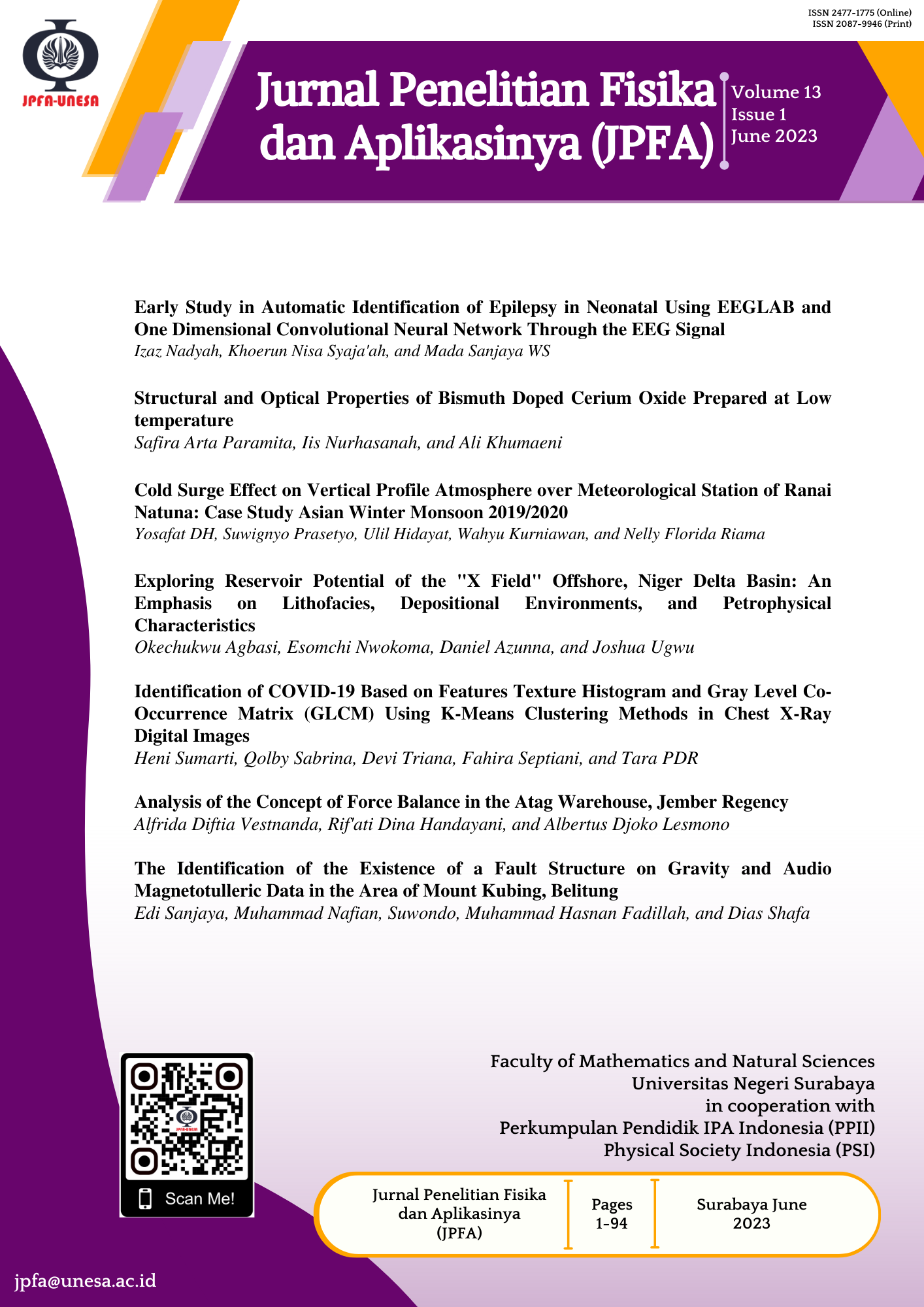Exploring Reservoir Potential of the "X Field" Offshore, Niger Delta Basin: An Emphasis on Lithofacies, Depositional Environments, and Petrophysical Characteristics
DOI:
https://doi.org/10.26740/jpfa.v13n1.p38-50Keywords:
Deposition, Permeability, Porosity, ReservoirAbstract
The geological circumstances under which sediments are built throughout time are referred to as depositional environments. The features of the sediment, such as its texture, composition, and permeability, are influenced by these depositional environments, and these qualities ultimately define the reservoir quality. This study focuses on identifying reservoirs in the western offshore region of Nigeria's Niger Delta Basin and evaluating their properties, such as lithofacies, distribution, and petrophysical characteristics like porosity and permeability, using well log analysis. By utilizing relevant and easily accessible well log data, the depositional environment and quality of the reservoir were evaluated. The data analysis involved examining gamma-ray log patterns, spontaneous potential, deep resistivity, neutron, and density. The thickness of the reservoirs varies between 15 and 440 meters, with thicker reservoirs likely being composite structures formed from layered channels. Sands deposited in high-energy settings have higher levels of porosity and permeability. Sands C and D are the most porous and permeable sand units in the field, while the remaining sands have medium permeability. Hydrocarbons are present in sands B, C, D, and E in varying fluid types and column diameters. The reservoir sands C, D, and E have high hydrocarbon saturation and low water saturation, indicating that more oil than water will be produced. On the other hand, irreducible sand B suggests that more water than oil will be produced. Reservoir sands B, C, and D contain only water and oil. This information can aid in locating production platforms and optimizing hydrocarbon recovery, as well as improving reservoir performance estimates. The geological and petrophysical data collected in this study can also guide the analysis of other fields similar to the "X Field" in Nigeria's Niger Delta offshore region.
References
Harry TA, Etim CE, and Agbasi OE. Petrophysical Evaluation of H-field, Niger Delta Basin for Petroleum Plays and Prospects. Materials and Geoenvironment. 2022; 68(2): 1-11. DOI: https://doi.org/10.2478/rmzmag-2021-0020.
Nwokoma E, Agbasi OE, and Dinneya O. Prediction of Litho-Porosity Using Incompressibility and Rigidity, Offshore Niger Delta, Nigeria. Geoinformatica Polonica. 2022; 21: 31-42. DOI: https://doi.org/10.4467/21995923GP.22.003.17081.
Reijers TJA. Stratigraphy and Sedimentology of the Niger Delta. Geologos. 2011; 17(3). 133-162. DOI: https://doi.org/10.2478/v10118-011-0008-3
Doust H and Omatsola E. Niger Delta in Edwards JD and Santogrossi PA, eds., Divergent/passive Margin Basins, AAPG Memoir 48. Tulsa: American Association of Petroleum Geologists. 1990; 239-248.
Weber KJ and Daukoru EM. Petroleum Geological Aspects of Niger Delta, Tokyo. Ninth World Petroleum Congress Proceedings, 1975; 5(2), 209-221.
Short KC and Stauble AJ. Outline of the Geology of the Niger Delta. American Association of Petroleum Geologists. 1967; 51: 761-779. DOI: https://doi.org/10.1306/5d25b57d-16c1-11d7-8645000102c1865d.
Nton ME and Rotimi S. Reservoir Characteristics and Palaeo Depositional Environment of Duski Field, Onshore, Niger-Delta, Nigeria. Global Journal of Geological Sciences. 2016; 14(1): 49. DOI: https://doi.org/10.4314/gjgs.v14i1.5.
Agbasi OE, Chukwu GU, Igboekwe MU, and Etuk SE. Pore Fluid and Lithology Discrimination of a Well in the Niger Delta Region Using Elastic Parameters. World News of Natural Science. 2018; 17: 75-88.
Agbasi OE, Sen S, Inyang NJ and Etuk SE. Assessment of Pore Pressure, Wellbore Failure and Reservoir Stability in the Gabo Field, Niger Delta, Nigeria - Implications for Drilling and Reservoir Management, Journal of African Earth Sciences. 2021; 173: 104038. DOI: https://doi.org/10.1016/j.jafrearsci.2020.104038.
Etuk NO, Aka MU, Agbasi OE, and Ibuot JC. Evaluation of Seismic Attributes for Reservoir Characterization over Edi Field, Niger delta, Nigeria Using 3D Seismic Data. International Journal of Advanced Geosciences. 2020; `8(2): 168-172. DOI: https://doi.org/10.14419/ijag.v8i2.31043.
Asquith G and Krygowski D. Basic Well Log Analysis. AAPG Methods in Exploration Series 16. Tulsa,Oklahoma: The American Associaton of Petroleum Geologist; 2004.
Larionov VV. Borehole Radiometry: Moscow, U.S.S.R. Logging Symposium Paper. 1969; 10: 26.
Agbasi OE, Akankpo AO, and Essien UE. Estimation of Reservoir Potentials of Two Wells in Niger Delta Region, Nigeria. Journal of Geosciences and Geomatics. 2017; 5(2): 87-95. Available from: http://pubs.sciepub.com/jgg/5/2/5.
Archie GE. The Electrical Resistivity Log as an Aid in Determining Some Reservoir Characteristics. Transaction of the AIME, 1942; 146(01): 54-62. DOI: https://doi.org/10.2118/942054-G.
Adepelumi AA, Alao OA, and Kutemi TF. Reservoir Characterization and Evaluation of Depositional Trend of the Gombe Sandstone, Southern Chad Basin, Nigeria: Journal of Petroleum and Gas Engineering. 2011; 2(6): 118-131. Available from: https://oa.mg/work/10.5897/jpge.9000042.
Ojo O, Agbasi OE, Namdie I, Etuk S, and Robert U. Prediction of Pore Fluid and Lithology Using Incompressibility and Rigidity, Offshore Niger Delta, Nigeria. International Journal of Earth Sciences Knowledge and Applications. 2020; 2(3): 109-120. Available from: http://www.ijeska.com/article/view/34.
Akpabio I, Ibuot JC, Agbasi OE, and Ojo OT. Petrophysical Characterization of Eight Wells from Wire-line Logs, Niger Delta Nigeria, Asian Journal of Applied Science. 2014; 2(2): 105-109. Available from: https://ajouronline.com/index.php/AJAS/article/view/540.
Olayiwola AM and Bamford KM. Depositional Environment and Reservoir Characterization of the Deep Offshore Upper Miocene to Early Pliocene Agbada Formation, Niger delta, Nigeria. Journal of African Earth Sciences. 2019; 159: 103578. DOI: https://doi.org/10.1016/j.jafrearsci.2019.103578.
Okoli AE, Edward AJ, Ehirim CN, Dosunmu A, and Agbasi OE. Paleoenvironmental Reconstruction of an Onshore Field, Coastal Swamp Depobelt Niger Delta. Geoscience. 2019; 9(1), 18-26. Available from: http://article.sapub.org/10.5923.j.geo.20190901.03.html.
Schlumberger. Log Interpretation, Principles and Applications. Houston: Schlumberger Wireline and Testing. 1989; 21-89.
Downloads
Published
How to Cite
Issue
Section
License
Copyright (c) 2023 Jurnal Penelitian Fisika dan Aplikasinya (JPFA)

This work is licensed under a Creative Commons Attribution-NonCommercial 4.0 International License.
Author(s) who wish to publish with this journal should agree to the following terms:
- Author(s) retain copyright and grant the journal right of first publication with the work simultaneously licensed under a Creative Commons Attribution-Non Commercial 4.0 License (CC BY-NC) that allows others to share the work with an acknowledgement of the work's authorship and initial publication in this journal for noncommercial purposes.
- Author(s) are able to enter into separate, additional contractual arrangements for the non-exclusive distribution of the journal's published version of the work (e.g., post it to an institutional repository or publish it in a book), with an acknowledgement of its initial publication in this journal.
The publisher publish and distribute the Article with the copyright notice to the JPFA with the article license CC-BY-NC 4.0.
 Abstract views: 461
,
Abstract views: 461
, PDF Downloads: 502
PDF Downloads: 502









